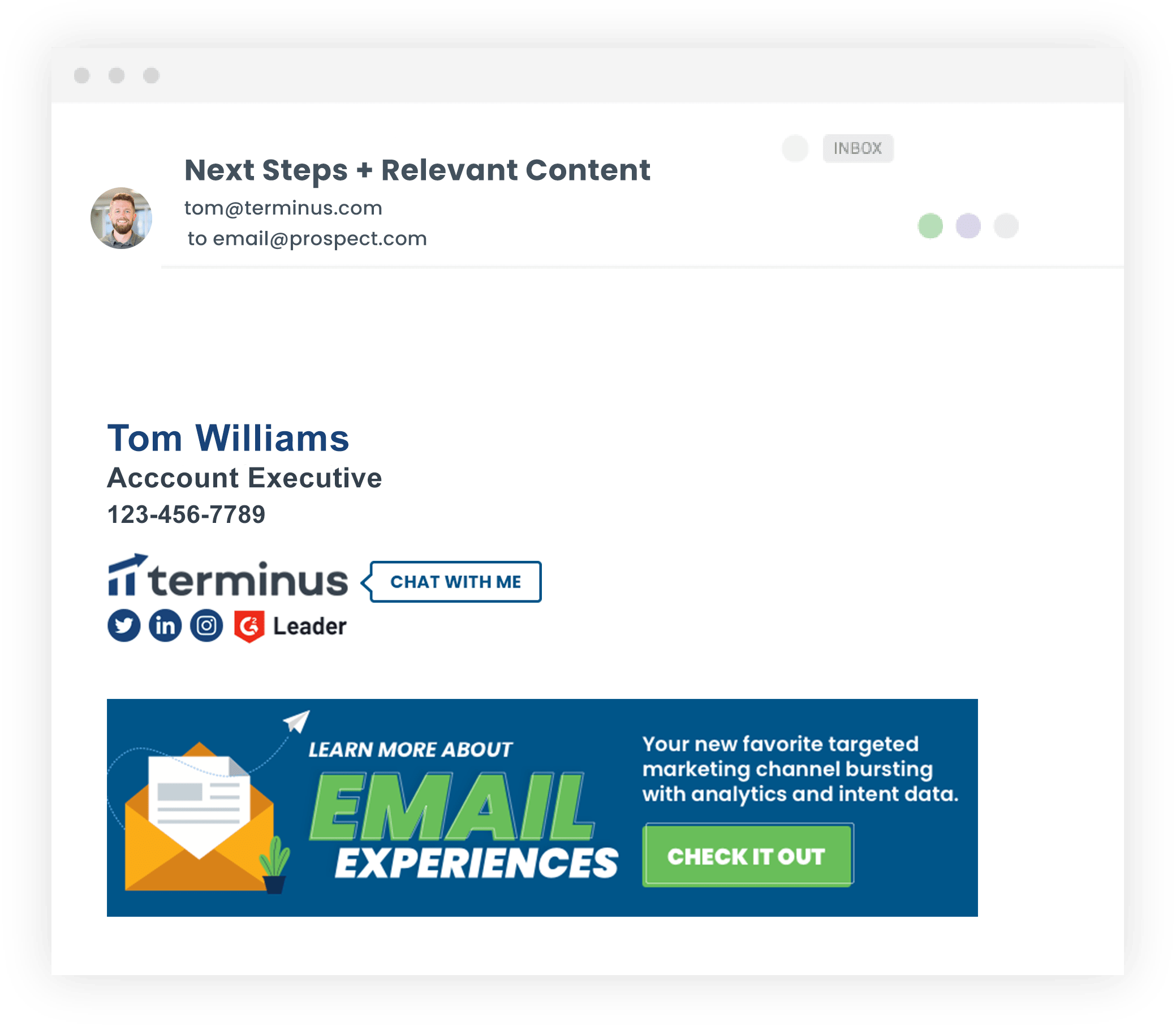
Terminus Email Experiences(Formerly known as Sigstr)

[Ebook] The Total Marketing Impact of Terminus Email Banners
Read it here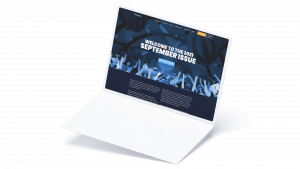
The 2021 September Issue (Email Banner Designs & Inspiration)
Get your copy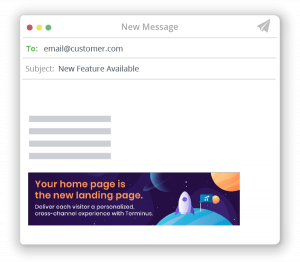
[Blog] 6 Examples of Using Employee Email as a New Account Based Marketing Channel
See more examplesEmail Footer
An email footer is often confused with an email signature. They both appear at the bottom of an email, but they play different roles. This guide takes a look at the differences and guides you toward best practices for email footers.
Email signatures should be added to emails that are sent directly between two or more individuals. For instance, if you own a business, you should talk with your employees about email signature ideas to ensure that they are including their name, contact details, and information about the company, and help them set up an HTML email signature code.
You can allow your employees to use creative email signatures that showcase their personalities, but ideally, their professional email signature also needs to align with the brand image of your company. Whether your employees are using an email signature Outlook, an email signature Gmail, or an email signature on your internal email service, you should have them run it by you before they start using it.
A professional Gmail signature is also important for freelancers who want to look professional, and even students should develop a professional email signature student when they send emails to professors, mentors, and other students.
An email footer, in contrast, doesn’t go at the end of emails sent from individuals. Instead, it should appear at the end of emails that you use for marketing purposes or at the end of your email newsletter. Rather than containing the personal information about an employee, a freelancer, or a student, an email footer contains information about a company.
Once someone has read a marketing email, they should be able to look at the bottom of the email and be able to figure out how to contact the company, how to find the company on social media, and how to unsubscribe from future emails.
You can also use the footer to encourage the reader to take more actions. You may want to encourage them to forward the email to their friends, click a link to buy a product, or do something else. Ultimately, you get to decide how to use your footer in the way that best benefits your business.
Email Footer Design
Now that you understand the main distinction between an email signature and an email footer, it’s time to take a deeper look at their differences and similarities. Both email signatures and footers contain important information that you don’t necessarily want to include in the main body of the email, but the exact details are slightly different.
Both email signatures and email footers should contain information about the company including its name, website, physical address, and contact information. However, only the email signature should contain information about an individual and how to reach them.
Email footer design and email signature design can be very similar. They should both use easy-to-read fonts, they should present their information in hierarchical order with the most important information at the top, and they can both include visual elements such as logos or social media buttons.
You should develop an email template footer design to put at the end of your marketing emails, and to ensure you’re optimizing your design, you may want to use A-B testing to see which elements people respond to the most. A-B testing simply means that you create two email footer designs with a small difference. Then, you see which one has a better conversion rate, and you use that one. You can repeat this process indefinitely as you refine your approach to email footers.
You may also want to create an email signature design template for yourself and to create consistency with your employees. Make sure that they use a professional email signature design that is not overly casual and that represents your company in a positive light.
Email Footer Examples
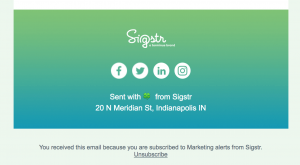

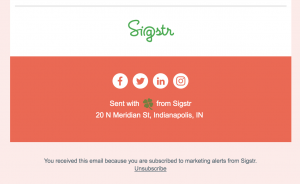
Coming up with ideas for your email signatures and footers isn’t always easy, but luckily, you don’t have to start from scratch. There are all kinds of places where you can get inspiration and design help.
As you develop your email signatures and footers, look for email signature or email footer examples. The examples will help you narrow in on which elements you want to include in the signatures and footers of your emails.
You may also want to look for email signature templates. Templates have the design already made, and you just plug in your personal elements. Templates are particularly helpful if you want cool background colors, interesting fonts, or images in the signature or footer.
With signatures, you may want to look for templates that are designed for the email program you’re using. For instance, a Gmail signature template or an email signature template Outlook can help you create a professional looking signature for these email programs. You can buy a template, or look for a free one by searching for a phrase like “free email signature templates for gmail”.
Remember, email signatures aren’t just for business use. You may also want to put a signature on your personal email, and you use personal email signature templates to help the creativity flow. Some templates even come in the form of email signature templates free download. Once you download the template, you can modify it to meet your needs.
Email Marketing Footer Examples
After you spend some time looking at email marketing footer examples, it’s time to put your ideas into action, but how do you get started? The process is surprisingly intuitive, and with just a little tech-savvy, you should easily be able to add footers and signatures to your emails.
To add a signature in Gmail, you simply click settings in the top right corner and select see all settings. Then, scroll down until you see the signature option and hit the button that says “create new signature” and type in your signature.
First, you name your signature, and then, an editing box opens that allows you to put in text, add different fonts, and personalize your signature. If you want to know how to add signature in Gmail app with logo, you just hit the button at the bottom of the editor that looks like white mountains against a black background, and this allows you to insert an image.
The instructions of how to insert image in email signature in Gmail, are the exact instructions you should use if you are wondering how to add signature in Gmail with logo. Just download your logo onto your computer, and then, upload it onto your signature.
Don’t have your computer handy? You can actually add a signature on your phone. Here’s how to add signature to Gmail on iPhone:
- Open your Gmail app.
- Hit the menu on the top left side of the app.
- Select settings (near the bottom of the menu).
- Select your email address at the top of the settings menu.
- Hit signature settings
- Turn mobile signatures on.
- Type your signature.
Email Footer Best Practices
As indicated above, email footer best practices include adding relevant information about your business, letting readers know how to contact you or find you on social media, guiding readers to the next action you want them to take, and offering an unsubscribe option. But how do you ensure that you have all these elements in your email? Consider using a generator.
Although email footers and signatures play slightly different roles, they are created by the same process, and an email signature generator can be used to make either a signature or a footer. You can find the best free email signature generator by doing a few web searches and trying out the top results.
The best email signature generator tools are easy to use, and they let you add colors, fonts, and images with a few taps of your mouse. If you don’t need to add a lot of links or images, you may be able to use a plain text email signature generator. If you use a specific program, you may want to look for a tool that can help you generate a signature for that particular program such as an email signature generator for GoDaddy.
The Canva email signature tool is a great place to get started. The Canva email signature clickable tool lets you create professional looking signatures, and it’s simple to use. It also offers templates for specific email programs like the Canva email signature for Outlook. Look for a free Canva email signature template if you just need a single signature, or consider upgrading to the professional version if you need to make multiple signatures for everyone in your company.
Email Footer Design Size
There are so many different options and designs you can choose for your email signature or footer. What email footer design size should you use? What email signature size looks the best? What colors should you add behind the text? What color should you use for the text? What order should you put your information? These are just some of the questions you’re likely to face as you work on your email footers and signatures.
The best way to get ideas is to look at email signature examples. Look at examples that are directly related to your program such as Gmail signature examples, but also try to find signature ideas that match your objectives. For example, you should look at personal email signature examples if you’re trying to draft a signature for personal use and professional signature examples if you’re making a signature for work.
Also, look for footers that are used in the way you plan to use your footers. For instance, email newsletter footer examples can guide you in the right direction if you’re looking for ways to close out your newsletter, but you may want to use a different design for marketing emails.
The more you look at examples, the easier it will be to figure out the best email signatures and the right email signature format for your needs. Now that you understand the process, it’s time to dig in an look for examples. Then, you can start creating all kinds of effective signatures and footers.




